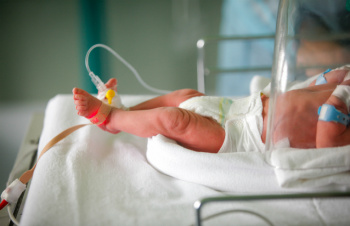News
New bioengineering approach to fix fetal membranes
13 October 2020

The study, published in the journal Prenatal Diagnosis, found that these molecules, known as peptide amphiphiles (PAs) self-assemble to form a ‘plug’ that seals holes within the fetal membranes, and could potentially help repair any damage.
For the study, the researchers established a fetal membrane defect model, which mimics the creation of a defect site within the fetal membrane as a result of keyhole surgery. They assembled donated human fetal membrane tissue onto cell culture dishes and injected human amniotic fluid, the protective fluid which surrounds the developing fetus, underneath. The injection creates a small hole within the membrane and the PAs were then added to this site.
The research team found that PAs spontaneously assembled together seconds after coming into contact with the human amniotic fluid. Within two minutes, a dense mesh of fibres formed a plug, which sealed the hole created at the injection site after 24 hours.
When they combined this novel use of PAs with protein sequences known to promote adhesion and healing, the researchers observed an enhanced sealing and regenerative effect.
Dr Tina Chowdhury, Senior Lecturer in Regenerative Medicine at Queen Mary, said: “The next step in this research is to understand whether these molecular ‘plugs’ are able to withstand the mechanical forces such as tension or pressure induced by the developing fetus and the amniotic fluid. We also need to explore the wound healing mechanisms in more detail, and the safety of using the peptides for expectant mothers and babies during pregnancy.”
The findings follow on from previous work from the research team, which showed that reducing the levels of a protein called connexin 43 (Cx43) encouraged rebuilding of the fetal membranes, and enhances the processes of tissue healing and repair.
Improving outcomes
Whilst PPROM can occur spontaneously, it can also result from fetal surgery and prenatal diagnosis procedures such as amniocentesis that require doctors to make a hole in the fetal membrane sac.
Fetal medicine specialists are increasingly offering surgery to babies in the womb before birth, to treat abnormalities of the spine, diaphragm or placenta. PPROM complicates around one-third of these cases, reducing the clinical effectiveness of fetal surgery.
Professor Anna David, Professor of Obstetrics and Fetal Medicine at UCL Elizabeth Garrett Anderson Institute for Women’s Health and a co-author of the study, said: “Finding a method to heal the amniotic membranes and prevent preterm birth after PPROM is a vital step to improving the outcomes of babies where the membranes rupture. The sealing and regeneration that we saw is very encouraging for our bioengineering approach.”
First steps to identifying treatments
The integrity of the fetal membranes during pregnancy is vital for normal development. The premature rupture of fetal membranes, known as preterm prelabour rupture of the membranes (PPROM), is a major cause of preterm birth accounting for around 40 per cent of early infant death.
Currently there are no clinical approaches available to repair or improve healing in the fetal membranes.
Head of Research at Rosetrees Trust, Dr Vin Rajkumar, said: “Rosetrees Trust is delighted to have supported Dr Tina Chowdhury's research on the molecular mechanisms that can cause PPROM. We hope that these findings will be the first steps to identifying potential treatments for this condition.”
Kiki Syrad, Director of Grants and Impact at Sparks, the children’s medical research charity, commented: “We’re delighted to see the progress made on this vital project to understand more about how to reduce the risks of PPROM and preterm birth to babies. We hope these findings and further research in this area will one day help more children to enjoy a healthy start in life. This research demonstrates the importance of early funding and we’re thrilled to support Dr Chowdhury and her team’s important work.”
The research was supported by funding from Sparks and GOSH children's charity (17QMU01), Rosetrees Trust (M404), KU Leuven University Fund, NIHR UCLH Biomedical Research Centre, Little Heartbeats and the Prenatal Therapy Fund, University College London Hospital Charity.
| Website: | |
| People: | Tina CHOWDHURY |
| Research Centre: | Bioengineering |




